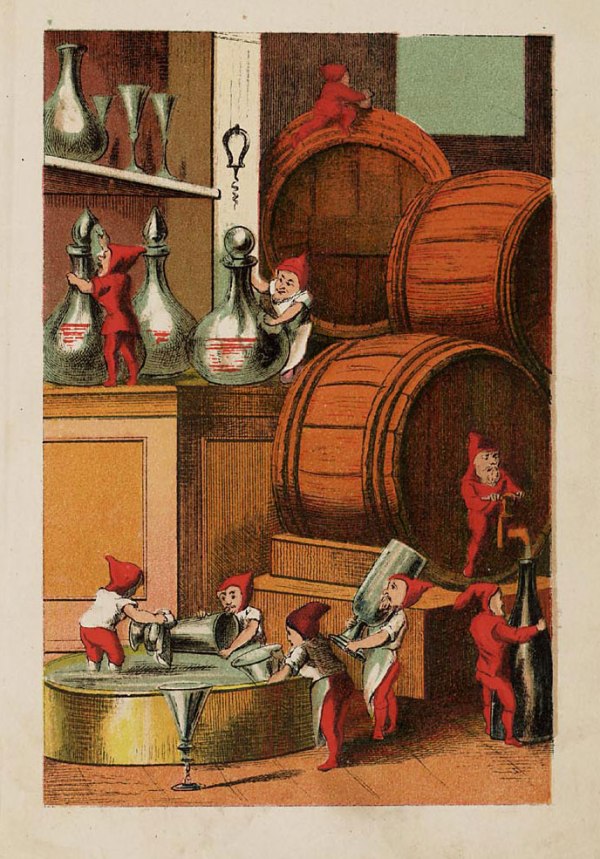
With “By Hand & Eye” at the printer, our sights are set on completing the first volume of the A.J. Roubo translation.
All I can say is thank goodness for Jeff Burks. If it weren’t for his regular stream of research, I wouldn’t have much to post here except: “Day 630, still editing Roubo and looking stuff up in the original French.”
During this admittedly drawn-out process, several readers have said something like: “Come on. Just run the text through a translation program. Look up the weird words the translation program doesn’t recognize and be done with it.”
To demonstrate what that piece of rotten sausage that idea is, here is a simple exercise in that process. Jeff Burks sent me a cool Dutch children’s book called “De historie van de kaboutermannetjes” from 1873. The kaboutermannetjes are like gremlins and get into all sorts of mischief. I extracted the text and ran it through Google’s translate program.
And here’s what comes out. Reading it out loud is hilarious, particularly after two beers.
Download the original book in the Dutch here.
Kaboutermannetjes
— Christopher Schwarz
The History of the Gnome Males
Oh, what a golden age was that,
When m ‘in every home in country and city
Gnome Mannekes had,
That was a maid ‘journey lazy and slow?
Or deemed d ‘labor acid plague,
Pst! came at night,
If mice so soft,
And scoured and performing ablutions,
And washed and splashed,
And auctioned,
And mopped,
And wormden and saddled,
And scrubbed and scrubbed,
So that was the hour to stand by on
The maid àl ‘t homework was done.
The metslaarsknechts and carpenters
Also had hard work of the effervescent,
There, they thought it was small-menfolk
And d ‘labor over for them.
‘t handle hammer and ax,
Drill, truffle and file,
The addict and trotted,
The drilled and scraped,
It added,
The toiled,
As it withers and food
Gladweg was forgotten,
Until very ‘t chore was dismissed
And the people could go. Pub or bed
The baker and his white servant
Deen but also what their well thought only,
Because, if it’s small people saw them luiren,
Came it from the chimney for the day.
They took the flour
From attic or part,
They sifted and kneaded it,
They weighed and did it,
they moved
‘t In d’ oven,
Stoking the coals on
And fit well on
Until, at the crowing of the cock,
The boss’ t diff baking was done standing.
it went to the butcher just so far:
Had that night to a pig or cow,
But he and his servant often,
‘t Leprechaun People helped with entertainment.
Keelden that the animal,
Which made it nigh,
Who went to ‘t heels,
Getting it down and snap,
That flushing,
Which churned,
Who smeared and spilled,
Who stopped the sausages,
And, dear broke tomorrow,
‘t Meat was only to save. upon the hook
The kastlein tasted sweet in inward peace
But up to his guests;
Because it was all his work which he drank,
There until he sank down on.
So he lay at rest,
Then it was a delight,
How it small people are repelled,
‘t In’ t chalk standing noted,
How it pondered,
How it appropriate,
To room and buffetkas
Weather was just pure and
And where they looked but around,
Every thing was good in the place again.
Sat once a tailor in pain,
Because a suit had to be ready soon
He slate but it drape down with him
And went to ‘t snore like a bear.
Went with a seesaw
‘t Kleine-folk to the cut;
She tucked and stung,
They zoomed and suffocated,
Garneerden,
Watt migrants,
And pierced and sewed,
And squeezed and twisted
At night through – if the tailor stood on,
Had the Sinjeur ‘t new suit already.

Oh dear, now done that time;
‘t Leprechaun People is to the moon!
One can not loafing more,
It should present themselves busy;
Currently some will,
Not to sit still,
Who keep themselves awake dough,
That stir themselves …. the wretch!
That gape,
That her lie,
Clean it long hour of rest there,
Is not ready for his work. –
So, boys, girls! keeps you well,
And do your duty with courage frischen.
Like this:
Like Loading...
 To all of you who have supported and encouraged us along the path of completion for “To Make As Perfectly As Possible: Roubo On Marquetry,” please congratulate yourselves on making André-Jacob Roubo one happy man. Here is a revealing paragraph from the Conclusion of the original treatise.
To all of you who have supported and encouraged us along the path of completion for “To Make As Perfectly As Possible: Roubo On Marquetry,” please congratulate yourselves on making André-Jacob Roubo one happy man. Here is a revealing paragraph from the Conclusion of the original treatise.








